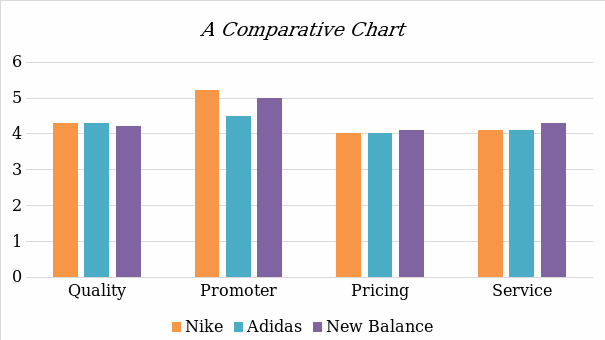Nike is a world-famous American company, mainly known for the production of high-quality, comfortable, and stylish sneakers. It is no secret that the corporation has its own goals, plans, strategies, and methods of solving problems, as well as both positive and negative sides that need to be properly eradicated. Moreover, various external and internal conditions can directly affect the further success and prosperity of the entire firm. Therefore, like any company, Nike requires a comprehensive analysis that could allow one to see a holistic picture of the situation and determine further steps in a positive direction. Thus, this paper focuses on the preparation of a marketing plan and thorough investigation in order to determine further actions for the formation of a sustainable business.
Marketing Plan: Nike
Table 1. SWOT Analysis
Strengths
Primarily, Nike has a fairly good reputation and brand awareness; the company has a wide range of high-quality and fashionable sneakers that can be purchased in almost every corner of the world. Furthermore, research shows good consumer loyalty to the brand and many people have been buying Nike sneakers for a long period (Liu, 2021). In addition, the firm actively cooperates with some celebrities from the world of sports, such as Michael Jordan (Liu, 2021). In fact, effective cooperation with the stars sometimes has the power to affect the influence of the brand.
Weaknesses
As practice shows, Nike’s activities, in particular, depend on the weather, natural conditions, and policies within the countries of production, which could affect the entire industry. Additionally, in this situation, it is also necessary to recognize that the company has such a tendency as a high percentage of the ratio of liabilities to assets (Liu, 2021). Nike has a certain debt structure that requires thorough systematization and optimization. Otherwise, the weakness of the firm may develop into a special threat.
Opportunities
In general, Nike has good opportunities to expand its business in regions that could allow for greater profits. The company also has a chance to transfer the procedure for selling sneakers to the Internet space due to the unfavorable global situation, such as the spread of coronavirus. As a rule, online marketing shows more improved and stable results compared to retail indicators (Liu, 2021). Consequently, Nike needs to adjust and improve the online sales area to keep up with the progress.
Threats
Fluctuations in the economy, uncertainty, and instability both within countries and around the globe can create certain troubles for Nike, especially affecting its financial performance. In particular, the threat comes from a wide range of competitors, such as Adidas and many other famous firms (Liu, 2021). Moreover, one should mention the COVID-19 pandemic, which dealt a blow to many enterprises, including the Nike business model, and required rapid adjustment to new conditions.
Competitive Analysis

Goals
The goals of this marketing plan should include the desire to realize a balance in price offers, improved customer service quality, advanced client loyalty, increased product value, and growth of the company’s market share. Thus, knowing the goals, Nike will be able to quickly focus on such objectives as identifying the right consumer, conducting effective campaigns, increasing profitability from sales, and prioritizing the allocation of resources. The author of this plan seeks to achieve systematization of marketing processes and activities, simplification of the system of control, and evaluation of results. Such a project will help to predict sales results and the success of Nike’s activities, make the work of the marketing department transparent, as well as find growth points and weaknesses, as this will help to build up from competitors.
Corporate Social Responsibility, Sustainability, and Ethics Strategy
In order to be socially responsible and ethical towards people, nature, and the company’s activities, it is essential to refer to the corporate social responsibility policy within the framework of economic responsibility. According to Stobierski (2021), this policy allows Nike’s leaders to support financial actions and decisions while striving to do good in the environmental, ethical, and philanthropic fields. It should be remembered that the intended result is not only earnings maximization, but also a positive impact on the environment, the state, and the people. Accordingly, the aspects of the business model that will allow for more sustainable activities should include customer orientation (needs), product value (advantages), and internal elements (approaches). Thus, this approach will create the necessary conditions to improve people’s lives and help the planet, while maintaining a decent profit.
Conclusion
Summarizing the above, it should be stated that the designated goals and objectives were successfully fulfilled, and the marketing plan was implemented positively. In this paper, it was possible to identify the strengths and weaknesses of Nike, as well as business growth opportunities and external threats. The comparative characteristics of Nike with two competitors demonstrated the areas that need to be further strengthened and refined for the firm to remain a leader in the industry. The marketing plan’s purpose is to place special emphasis on increasing profits and improving the customer-oriented approach. In order to do this, it is important to turn to the corporate social responsibility policy, which could help both people and nature, while maintaining good incomes.
References
Liu, X. (2021). Nike’s general company analysis based on it 2020 annual report.Advances in Economics, Business and Management Research, 166, pp. 799-803.
Nike competitors. (n.d.). Comparably.
Stobierski, T. (2021).Types of corporate social responsibility to be aware of. Harvard Business School Online.